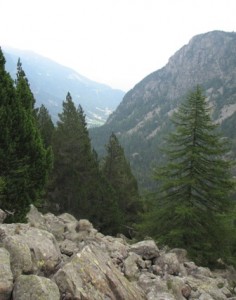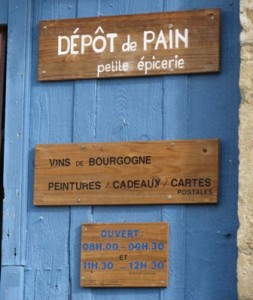Sherlock (grazieeeee!) sent me a study titled “Dietary flavonoids inhibit the anti-cancer effects of the proteasome inhibitor Bortezomib” (see abstract: http://tinyurl.com/5pdxtu), published in the July 16 2008 issue of “Blood.” This is an important study for those who are taking Velcade (Bortezomib) and supplements at the same time, so I decided to read, and post about, the full study. It’s quite a long post, sorry about that!
Quercetin is the most mentioned compound in this study. As you can read on my Quercetin Page, quercetin is a plant chemical, specifically a flavonol, found in apples and red onions and a variety of other foods such as capers, broccoli and red grapes.
In the abstract we can read that quercetin inhibited the killing effect of Bortezomib on primary CLL and malignant B-cell lines. Interestingly, though, when inorganic boric acid (a low toxic substance derived from boron, an element found in rocks, soil and water) was added to the quercetin-Bortezomib combination, this inhibitory effect was diminished. Let me highlight that the cell lines under scrutiny were CLL (=chronic lymphocytic leukaemia) and other malignant B-cell ones.
And what about myeloma cell lines? Well, the researchers found that quercetin had a direct effect on myeloma cells, which sounds like very good news. Indeed, the researchers write, At high doses, quercetin itself induced tumor cell death. Death to myeloma cells? Yippeedadoodee! (Except that I recall reading that we should not take high doses of quercetin, I don’t remember why right at the moment, but I have never taken more than 1.5 grams/day of this supplement, so please be cautious…).
Let’s go on to the full study now. I might as well fess up right at the beginning that I didn’t understand all of it. So I will concentrate on the bits that I did understand. An interesting titbit is that Bortezomib kills CLL cells in vitro but does not display substantial anti-tumor activity in patients with CLL. So Bortezomib has anti-cancer activity in a lab setting but not when administered to CLL patients. Just goes to show that sometimes, unfortunately, in vitro anti-cancer activity cannot necessarily be reproduced in vivo.
The researchers then tell us that Quercetin is one of the most abundant flavonoids in the human diet and is a potent anti-oxidant. In fact, and this is something I did not know, quercetin is the chief dietary flavonol present in the blood. It is also a proteasome inhibitor, as is Bortezomib.
Let’s get to some results. As the abstract anticipated, there is definitely interference between quercetin and Bortezomib as far as CLL cells and other malignant B-cell lines are concerned. Not a good thing, clearly.
Two specific myeloma cell lines were also tested. In order to fight the killing activity of Bortezomib, however, these cells had to be treated with a very high dose of quercetin: Quercetin also had the same inhibitory effect on Bortezomib-induced apoptosis in two myeloma cell lines, U266 and RPMI-8226. However, the myeloma cell lines required higher levels of quercetin (40 micro-M) for maximal inhibition of Bortezomib-induced apoptosis, as compared to 20 micro-M for primary CLL, HRC57 and DoHH2 cells.
Then we read that In addition, myeloma cell lines were more susceptible to quercetin-mediated G2/M arrest compared with the B-lymphoma cell lines. So, in sum, when myeloma cells are “pre-incubated” with a not-too-high-dose of quercetin, their sensitivity to Bortezomib increases, which is a good thing. And another thing: myeloma cells can apparently be killed outright by quercetin, if I understood this part correctly. Of course, in vitro effects may not be the same in vivo, as we know. Proceed with caution, as always.
At any rate, further on we can read a possible explanation for this peculiar occurrence. When quercetin and Bortezomib were added at the same time, the former had an inhibitory effect on the latter. But when myeloma cells were pre-incubated with quercetin, the inhibitory effect was less evident: However, in both myeloma cells lines, pre-incubation with quercetin led to less inhibition on Bortezomib-induced killing, suggesting that myeloma cells are more active in their uptake and utilization of quercetin, thereby reducing the chemical binding between quercetin and Bortezomib. So myeloma cells, unlike CLL cells, gobble up quercetin, which is how the chemical bonding between the two substances can be avoided. Interesting.
I will skip the technical part about Bax activation and go on to a more comprehensible section. (Anyone interested in that part, though, can drop me a line; I would be glad to forward the study.)
The researchers tested other dietary flavonoids, such as myricetin (found in grapes, berries, fruit, veggies, herbs and walnuts), apigenin (in parsley and celery) and kaempferol (in broccoli, tea and grapefruit) , which, like quercetin, are antioxidant compounds possessing anti-proteasome activity. Of these, only myricetin had an inhibitory effect on Bortezomib. Interestingly, its chemical structure is similar to that of quercetin. Makes sense.
The researchers conclude that there are many dietary flavonoids which have similar structures with quercetin or myricetin, so the intake of dietary flavonoids may reduce the killing activity of Bortezomib on circulating leukemic cells.
Other findings: EGCG has an inhibitory effect on Bortezomib, so I probably wouldn’t drink any green tea if I were taking Velcade. I also wouldn’t drink any Cabernet Sauvignon or eat cranberries or Concord grapes, which contain a compound called delphinidin that also inhibits Bortezomib. As does cyanidin, found in many types of berries including grapes, blackberries, blueberries, cranberries, raspberries and cherries; and also in apples and plums.
But there is some GOOD NEWS: curcumin and resveratrol were also tested and found to be okay when taken together with Bortezomib, which confirms what I had read in other studies.
In the Discussion part I found another interesting titbit that is a bit on the technical side (sorry about that!)…here is the full quote: Quercetin and Bortezomib share similarities with respect to proteasome inhibition and the induction of apoptosis. They both can be used in the treatment of cancer. However, the differences between these two compounds are (1) Bortezomib is a boronic dipeptide acid and quercetin is a flavonoid; (2) Bortezomib is a ROS-inducing agent and quercetin is an anti-oxidant. The question is whether they are synergistic or counteract each other in combination. We observed that quercetin prevented Bortezomib-induced ROS generation and apoptosis in primary CLL cells. However, quercetin also blocked Bortezomib-induced apoptosis in B-cell lines in which ROS generation was not evoked. I repeat, this inhibitory effect of quercetin on Bortezomib is true for CLL and other malignant B-cells. Not for myeloma cells.
Further on, we read that, while Bortezomib does not seem to work well for CLL patients, it is highly active in myeloma, another B-lymphoid malignancy, suggesting differential sensitivity to Bortezomib according to tumor type. Also, and this sort of repeats what I have written earlier, myeloma cells pre-incubated with quercetin were not as protected as CLL cells from the apoptotic effect of Bortezomib. The researchers suggest that quercetin (at 20 micro-M) has a direct effect on myeloma cells, but not CLL, HRC57 or DoHH2 cells, to increase sensitivity to, and/or synergize with, Bortezomib.
The researchers add that it is not known if dietary quercetin (i.e., not in supplement form) would interfere with Bortezomib. So CLL patients don’t necessarily have to stop eating apples and onions (the easiest thing to do is ask your doctor). And they also remind us that Not all dietary flavonoids can inhibit Bortezomib. Myricetin showed a similar effect to quercetin on the inhibition of Bortezomib, but kaempferol and apigenin did not.
The study ends as follows: The differential in vivo activity of Bortezomib seen in myeloma and CLL may partly be attributable to the effect of dietary flavonoids: quercetin primes myeloma cells, but not CLL cells, such that they become more sensitive to Bortezomib-induced killing. Further work will elucidate the in vivo significance of these findings, which in turn will inform the need for dietary advice on the intake of flavonoids, as well as drug manipulation of flavonoid activity.
Hmmm, just as I had written a few concluding sentences and was about to publish this post on my blog, I did a quick online search just for the heck of it and came across a pertinent June 2008 “Haematologica” report (http://tinyurl.com/6hzqjg) whose findings made me add the following paragraph.
A group of Korean researchers tested six polyphenols—rutin, quercetin, caffeic acid, gallic acid, EGCG, and tannic acid—discovering that they all inhibited the anti-cancer activity of Bortezomib. Well, we already knew about quercetin and EGCG, so that is nothing new.
Now, the following is mere speculation on my part, but I have the feeling, based on what I understood from the July “Blood” study, that these compounds may have been added to the myeloma cell lines at the same time as Bortezomib, and that might explain the interference.
My point: the Korean study results might have been different if these substances had been added an hour or so before Bortezomib, which would have given the myeloma cells enough time to gobble them up, thus diminishing the interference potential. Pre-incubation with these polyphenols, in other words, might have made the myeloma cells more sensitive to the killing effect of Bortezomib, which would agree with the “Blood” study results. Again, since I have not seen the full Korean report, this is pure speculation on my part.
After reading this abstract, though, I would be concerned if I were taking Velcade and any of the above-mentioned and possibly interfering compounds (not curcumin or resveratrol, I repeat). So, here is my advice to Velcade-takers: please consult your doctor before adding anything to your protocol. Best to be on the safe side.
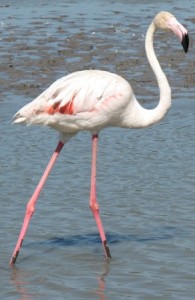 I am still in holiday mode, also a bit tired (tired from a HOLIDAY, shame on me!!!), so I am not doing any research or reading any of the interesting material sent to me by some of you (thanks!). I will in the next few days or so. In the meantime, here is another petit anecdote.
I am still in holiday mode, also a bit tired (tired from a HOLIDAY, shame on me!!!), so I am not doing any research or reading any of the interesting material sent to me by some of you (thanks!). I will in the next few days or so. In the meantime, here is another petit anecdote.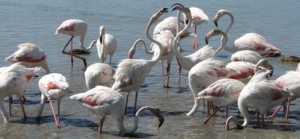
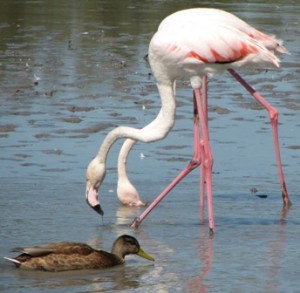 Right in front of me. Stunned, I was unable to move for a moment (this incident occurred before I’d had some coffee, so reflexes were on the slow side…). Unfortunately, by the time I had grabbed my camera, the bird was gone. I got a miserable shot of its big wings flapping in the distance. Not worth posting.
Right in front of me. Stunned, I was unable to move for a moment (this incident occurred before I’d had some coffee, so reflexes were on the slow side…). Unfortunately, by the time I had grabbed my camera, the bird was gone. I got a miserable shot of its big wings flapping in the distance. Not worth posting.![]()
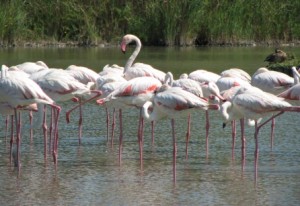 h, this part of the trip was so much fun. It is very entertaining to watch feeding flamingos (see photos 2 and 3; in 2 you can also see a couple of irritated males confronting each other). They dip their heads into the muddy water, then (almost as a group, it seemed to me) raise them, making rather dreadful honking noises and waving them about in the air. Then their heads, upside down so that their beaks can filter micro-organisms out of the water and mud, go back down into the water…again, almost simultaneously. Up, down, up…very odd to watch.
h, this part of the trip was so much fun. It is very entertaining to watch feeding flamingos (see photos 2 and 3; in 2 you can also see a couple of irritated males confronting each other). They dip their heads into the muddy water, then (almost as a group, it seemed to me) raise them, making rather dreadful honking noises and waving them about in the air. Then their heads, upside down so that their beaks can filter micro-organisms out of the water and mud, go back down into the water…again, almost simultaneously. Up, down, up…very odd to watch.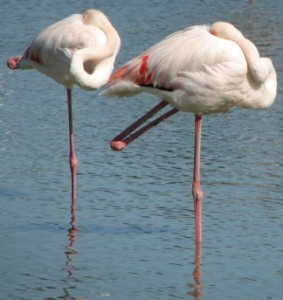 They really do sleep perched on one leg, with the other leg folded up under their bodies and their heads laid over their backs, as you can see in the last two photos.
They really do sleep perched on one leg, with the other leg folded up under their bodies and their heads laid over their backs, as you can see in the last two photos. 